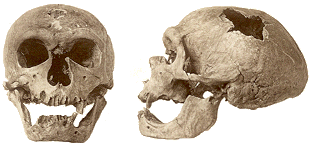In a previous blog (http://anthropologicalconcepts.weebly.com/blog/-physical-anthropology) I briefly mentioned primatology. But what exactly is primatology and what does a primatologist do? Furthermore, why are we spending so much time studying primates and why are physical anthropologists so interested in non-human primates? In the following blog I would like to discuss the matters these questions bring up.
Primatology is the study of primates, from what they eat, mating patterns, and so on. The most famous primatologist, Jane Goodall, has opened so many new doors for this field. With the time she has spent with chimpanzees since the 1960's has not only contributed to primatology, but also has showed that chimpanzees and humans are not all that different. I have mentioned in an earlier blog (http://anthropologicalconcepts.weebly.com/blog/-diet-and-teeth) that chimpanzees are omnivoures, and that they hunt, but Goodall has studied and witnessed far more human traits in chimpanzees. Many think that humans are the only species that can show compassion, and for those who also show compassion have been taught by humans, but this is not the case for chimpanzees. In her time with the chimpanzees Goodall saw so many moments of compassion. For example, in 1987 she was witness to a female chimpanzee, Spindle, adopting an orphaned chimpanzee, Mel. Even thought Mel was not a close relative, Spindle took her under her wing when Mel's mother died of pneumonia. What is more, she has “witnessed chimps performing a spontaneous dance-like display by waterfalls. Jane believes that this parallels expressions of awe that led early humans to religion.” There is also evidence with them eating medicinal plants when they have stomach aches or to “reduce internal parasites.”
Now primatology is not limited to the study of chimpanzees. All of the research primatologists have conducted have deepened our understanding of our own roots. That is the reason physical anthropologists are so interested in non-human primates. In some of the studies primatologists conduct they compare how alike modern humans and modern non-human primates are. “For example, the way in which the brains of rhesus monkeys and humans are organized is similar.” The more we study these cousins of ours, the more we understand what makes us human.
We may all be humans, but human, chimpanzee, gorilla, squirrel money, we are all primates. This is what makes physical anthropology such an exciting field. Anthropology is the study of humans, but to figure out what makes us human and how we got to being human requires extensive research about the past, but also the present. The Earth is pretty much already a planet of the apes. All different species, albeit all still very alike (humans and chimpanzees share 96 percent of their DNA).
Please feel free to comment on what you thought of the blog, or other physical anthropological subjects you would like me to cover.
Primatology is the study of primates, from what they eat, mating patterns, and so on. The most famous primatologist, Jane Goodall, has opened so many new doors for this field. With the time she has spent with chimpanzees since the 1960's has not only contributed to primatology, but also has showed that chimpanzees and humans are not all that different. I have mentioned in an earlier blog (http://anthropologicalconcepts.weebly.com/blog/-diet-and-teeth) that chimpanzees are omnivoures, and that they hunt, but Goodall has studied and witnessed far more human traits in chimpanzees. Many think that humans are the only species that can show compassion, and for those who also show compassion have been taught by humans, but this is not the case for chimpanzees. In her time with the chimpanzees Goodall saw so many moments of compassion. For example, in 1987 she was witness to a female chimpanzee, Spindle, adopting an orphaned chimpanzee, Mel. Even thought Mel was not a close relative, Spindle took her under her wing when Mel's mother died of pneumonia. What is more, she has “witnessed chimps performing a spontaneous dance-like display by waterfalls. Jane believes that this parallels expressions of awe that led early humans to religion.” There is also evidence with them eating medicinal plants when they have stomach aches or to “reduce internal parasites.”
Now primatology is not limited to the study of chimpanzees. All of the research primatologists have conducted have deepened our understanding of our own roots. That is the reason physical anthropologists are so interested in non-human primates. In some of the studies primatologists conduct they compare how alike modern humans and modern non-human primates are. “For example, the way in which the brains of rhesus monkeys and humans are organized is similar.” The more we study these cousins of ours, the more we understand what makes us human.
We may all be humans, but human, chimpanzee, gorilla, squirrel money, we are all primates. This is what makes physical anthropology such an exciting field. Anthropology is the study of humans, but to figure out what makes us human and how we got to being human requires extensive research about the past, but also the present. The Earth is pretty much already a planet of the apes. All different species, albeit all still very alike (humans and chimpanzees share 96 percent of their DNA).
Please feel free to comment on what you thought of the blog, or other physical anthropological subjects you would like me to cover.


 RSS Feed
RSS Feed
